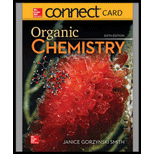
Concept explainers
(a)
Interpretation: The product formed by the treatment of given alcohol with
Concept introduction: The reaction of alcohols with halogen acids
(b)
Interpretation: The product formed by the treatment of given alcohol with
Concept introduction: Alkyl bromides are obtained by the reaction of
(c)
Interpretation: The product formed by the treatment of given alcohol with
Concept introduction: The reaction of alcohols with halogen acids
(d)
Interpretation: The product formed by the treatment of given alcohol with
Concept introduction: Alkyl chlorides are obtained by the reaction of
Want to see the full answer?
Check out a sample textbook solution
Chapter 9 Solutions
ORGANIC CHEMISTRY-ACCESS
- PLEASE HELP! URGENT!arrow_forward"Water gas" is an industrial fuel composed of a mixture of carbon monoxide and hydrogen gases. When this fuel is burned, carbon dioxide and water result. From the information given below, write a balanced equation and determine the enthalpy of this reaction: CO(g) + O2(g) → CO₂(g) + 282.8 kJ H2(g) + O2(g) → H₂O(g) + 241.8 kJ MacBook Airarrow_forwardPage of 3 4. Calculate AG for the following reaction at 25°C. Will the reaction occur (be spontaneous)? How do you know? NH3(g) + HCl(g) → NH4Cl(s) AH=-176.0 kJ AS-284.8 J-K-1arrow_forward
- true or false The equilibrium constant for this reaction is 0.20. N2O4(g) ⇔ 2NO2(g) Based on the above, the equilibrium constant for the following reaction is 5. 4NO2(g) ⇔ 2N2O4(g)arrow_forwardtrue or false The equilibrium constant for this reaction is 0.20. N2O4(g) ⇔ 2NO2(g) Based on the above, the equilibrium constant for the following reaction is 0.4. 2N2O4(g) ⇔ 4NO2(g)arrow_forwardtrue or false Using the following equilibrium, if heat is added the equilibrium will shift toward the reactants. N2(g) + 3H2(g) ⇔ 2NH3(g) + heatarrow_forward
 Chemistry: Principles and ReactionsChemistryISBN:9781305079373Author:William L. Masterton, Cecile N. HurleyPublisher:Cengage Learning
Chemistry: Principles and ReactionsChemistryISBN:9781305079373Author:William L. Masterton, Cecile N. HurleyPublisher:Cengage Learning
